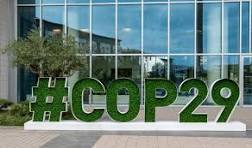
Some interest groups including Africa sought recognition of what their continents provide yet others benefit despite their unabated emission of GreenHouse Gases (GHGs) affecting the environment and depriving people from enjoying their rights.
With various commitments made by developed nations, key polluters of GreenHouse Gases among others to finance US$100 billion towards adaptation since COP 2015, debate around the interest groups during the November 11-22 meeting in Azerbaijan capital, Baku show that many, want answers and actualization of past commitment, now than pledges.
In trade, the United Nations’ World Trade Organisation (WTO), incensed at the delays previously, wants to know the status of climate finance, the backbone of any effective climate response which should be outlined clearly as it is needed to spur global trade as it tags along, Least Developed Countries.
Host nation, through its leader, and co-facilitated by UN Trade and Development (UNCTAD) and UN Development Program (UNDP), in collaboration with other United Nations agencies and global partners, like the World Trade Organization (WTO) and the International Trade Centre (ITC) insist on wrapping up the talk and ensure the resources be availed without delay.
“Trade, investment, and finance has to come together,” said UN Trade and Development Secretary-General Rebeca Grynspan alongside Azerbaijan’s Minister of Economy Mikayil Jabbarov and UNDP Administrator Achim Steiner.
Developing countries, despite being on the frontlines of climate impacts, receive minimal climate finance – only 1-2% of foreign direct investment in renewables, for instance, reaches Africa.
This investment disparity is a serious barrier to the green transition, as high borrowing costs prevent low-income countries from accessing the capital needed to make impactful climate progress, though there is some air of relief.
Development banks step up climate cash. Multilateral development banks (MDBS) have offered a helping hand and are extending financing to Least Developed Countries.
They expect that by 2030 their climate finance provision to low and middle-income countries will reach $120 billion a year – up by nearly half from the $75 billion handed out in 2023.
Number-crunchers at US think-tank natural resources defense council worked out that, as a result, the basis for the new UN climate finance target has now climbed to $197 billion by the end of the decade. That’s assuming bilateral finance provided directly by governments stays the same at the very least.
Nadia Calviño, president of the European investment bank, said “the family of multilateral development banks is walking the talk” with its new climate finance commitment, although experts think MDBS could and should go much further, while campaigners warn that the money needs to fund the right action on the right terms, the lenders said in a joint statement, Tuesday.
The 10 development lenders warned that their ability to do more largely depends on the commitment of their shareholders from both developed and developing countries.
The group of banks urged them to show “greater ambition”, adding that “additional capital” could “unlock more MDB financing.”
